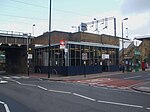Forest School, Walthamstow
1834 establishments in EnglandEducational institutions established in 1834Member schools of the Headmasters' and Headmistresses' ConferencePrivate co-educational schools in LondonPrivate schools in the London Borough of Waltham Forest ... and 2 more
Use British English from October 2019Walthamstow
Forest School is an private day school in Walthamstow in the London borough of Waltham Forest. The school occupies a large campus around its original Grade II listed Georgian and Victorian terraced buildings. The school has more than 1,430 pupils, aged 4 to 18, split equally between boys and girls.
Excerpt from the Wikipedia article Forest School, Walthamstow (License: CC BY-SA 3.0, Authors).Forest School, Walthamstow
Oakhurst Gardens, London
Geographical coordinates (GPS) Address Phone number External links Nearby Places Show on map
Geographical coordinates (GPS)
| Latitude | Longitude |
|---|---|
| N 51.5861 ° | E 0.0093 ° |
Address
Forest School
Oakhurst Gardens
E17 3PX London (London Borough of Waltham Forest)
England, United Kingdom
Open on Google Maps









